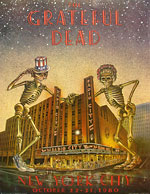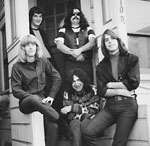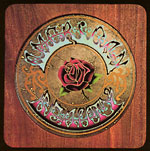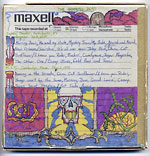Attics Of My Life
The Grateful Dead headlines at the New-York Historical Society By Rebecca Rego Barry
It has to be said: seeing “The Grateful Dead: Now Playing at the New-York Historical Society” (N-YHS) is a trip. The first indication that this exhibit is going to be different from other historical exhibit experiences is hearing the rock music pumped into the gallery. It’s very cool, and yet, one sympathizes with the guards; as any Deadhead will tell you, one song can last as long as a shift.
A visit to this exhibit offers some expected sights, such as concert posters, the band’s first record contract from 1966, some 45s and 33s, a platinum record of American Beauty, and plenty of dancing bears, all mounted on pink and purple wall panels that resemble speakers. But there are some breathtaking surprises too—such as a diorama (à la the Museum of Natural History) of dressed, life-size skeletons playing on stage. The beautifully designed concert tickets and backstage passes show us the artistic side of these musicians.
The archives related to the Dead’s Wall of Sound is another highlight. In 1974, the group devised the Wall—constructed of 604 speakers stacked 40 feet high—in an effort to achieve the best sound on stage. It cost the band $350,000 to set up, and $100,000 per month to maintain. Someone later noted on a legal pad, “Although nearly perfect in terms of the sound it produced—sharp and clear, with very little feedback or distortion—the logistics and costs of maintaining and transporting it proved untenable. The Wall of Sound was retired within the year.” Debra Schmidt Bach, assistant curator of decorative arts at the N-YHS, who co-curated the exhibit, said the thumbnail sketches of the Wall of Sound were the most exciting and surprising finds in the collection.
The “Now Playing” exhibit is the first large-scale exhibition of materials from the Grateful Dead Archive, located at the University of California at Santa Cruz. The collection contains 600,000 linear feet of books, recordings, business correspondence, posters, tickets, photographs, films, and props, much of which was collected by the band’s fan liaison, Eileen Law, who took over the job of preserving the Dead’s archives and “did a tremendous job,” according to Bach. The band donated the archive in 2008, and it is expected to open next year.
So how is it that the counter-cultural Dead became exhibit-worthy at the oldest museum in New York? It was Henry Kissinger’s idea. Well, not exactly. A couple of years back, Kissinger gave a lecture at the N-YHS during which he discussed the 1960s and its impact on American culture. Museum curators had been devising ideas for a new exhibit, and when one of their trustees told them about the recent Grateful Dead gift to Santa Cruz, it all seemed to come together, Bach said. “The archive is a great way to try to explore late twentieth-century culture.”
Indeed Deadheads were a sociological phenomenon of the time period. Between 1965 and 1995, the band performed more than 2,300 concerts and attracted half a million faithful fans, spanning at least two generations. One of the themes of the exhibit is the band’s intense relationship with its fans, as evidenced by fan letters, surveys, and most intriguingly, fan art. Over the years, Dead fans have mailed in 12,000 pieces of hand-decorated ticket envelopes. They also creatively customized audiocassette liners and sent them off to the group. The art and the devotion is a humbling thing to see on display only twenty and thirty years on.
The N-YHS exhibit opened in March and continues through July 4.












